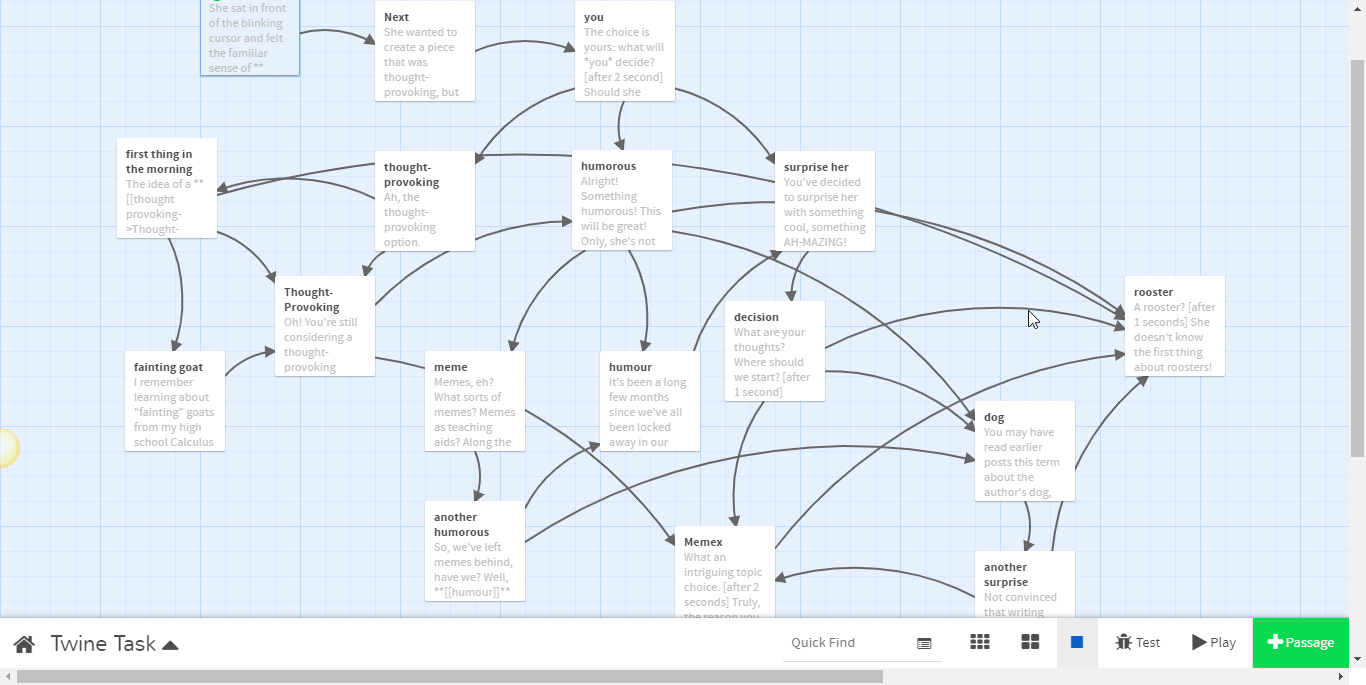For Task #5 (Twine Task), I’ve chosen to link to Norah Smith’s, Wedding Bells’ task. I must admit, I thought my journey through Norah’s task was going to be something along the lines of following a bride-to-be on her journey of becoming engaged, planning her wedding, and the actual ceremony. Ha! Instead, despite my best efforts, I always ended up in Florida celebrating the wedding with the bride and groom. At one point, I’m placed at a table with all the other outcasts at the wedding, but apparently the bartender and I have a great time. I take a trip to Vegas, then Muskoka; I choose to take shrooms (or not) and somehow manage to always end up in Florida. (Which for some reason has now become synonymous in my mind with Trump….).
Norah’s simple Wedding Bells Twine pokes fun at all the stereotypical nuisances associated with weddings. (I’ve certainly been privileged to have been a part of many, many weddings….). I laughed at the fact that I ultimately always ended up in Florida (even though I kept clicking on “NO”!). Like Norah, this was also my first attempt at using Twine so I’m still learning all of its ins and outs, but though I felt I learned an awful lot, I wasn’t able to figure out how to add the ‘go back’ option Norah added to hers. That was pretty helpful and awfully kind…it allowed me to keep making terrible decisions and encouraged me to try all possible paths to increase the likelihood that THIS time, I could make my life even MORE miserable. 😉
WordPress
Twine Context
When I arrived at Norah’s Twine task on her blog site, I was looking for the context in which she’d situated her task (such as Bush’s Memex thought experiment), but I only managed to find the link to her Twine .zip file. I think Norah might’ve missed an opportunity to compare and contrast her chosen theme/story for Twine with just how far we’ve come since Bush first published his Memex ideas in the mid 20th century. In fact, I think, given her chosen topic, she might’ve been able to add a lot of humour if she’d added a bit of a description to her task and prepped her audience a bit. Providing context wouldn’t have given anything away, rather I think it might have strengthened the overall user experience and made it more engaging and informative.
So, why did I choose to compare and contrast Norah’s Twine task with mine? Because they were quite different, really. My task was meandering and (intentionally) contained a few false starts; I tried to push the task to the limits given the time constraints I had during that particular week, whereas, Norah kept her task clean, simple, and miserable (wonderful!). 😉 I deliberately chose someone whose blog site and Twine task differed from mine to determine whether I can improve my site and Twine game the next time ’round. Overall, I’m pretty satisfied with what I came up with (it was quite silly though), but I think there is merit to simplicity as well-especially when you are learning a new tool for the first time. Additionally, Norah chose a different WordPress theme than me and it gave me a few insights into my preferences for specific components of UX and site design. After completing the User Inyerface activity later in the course, I can honestly say I have started to pay closer attention to site design and am really beginning to notice the bits and pieces that trip me up on a website.


